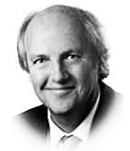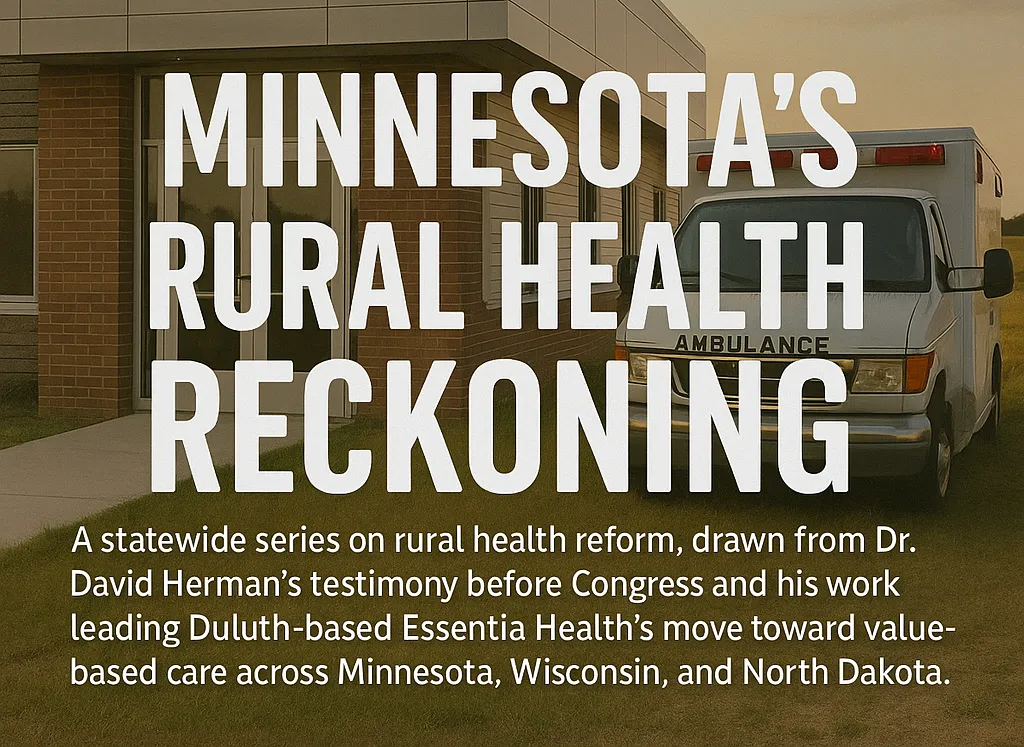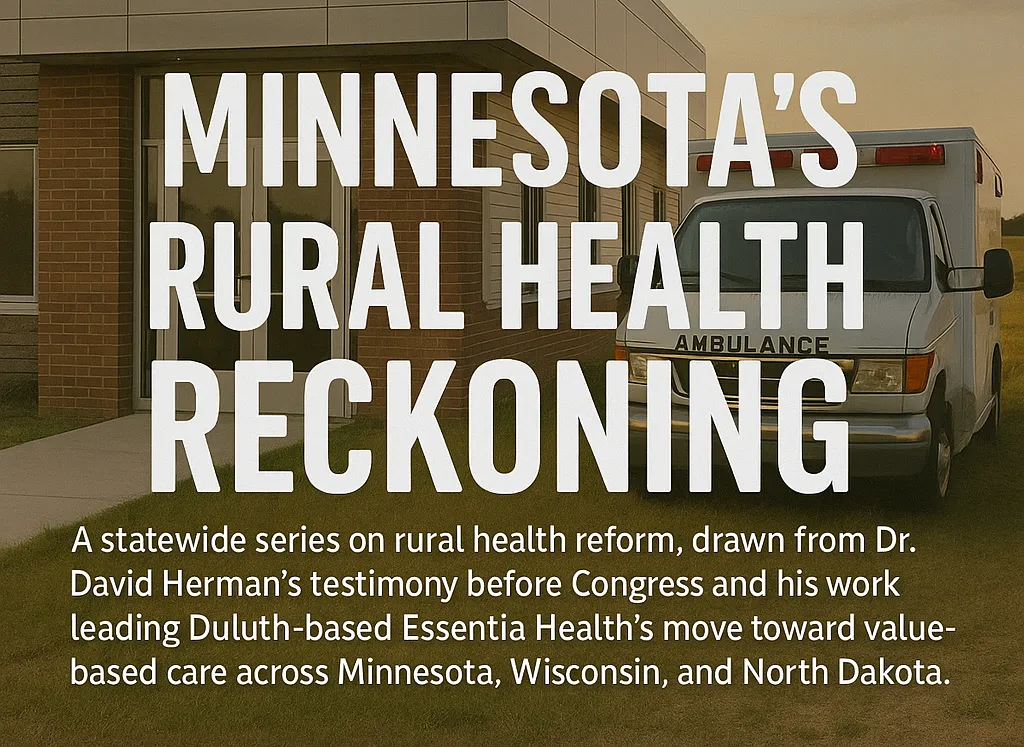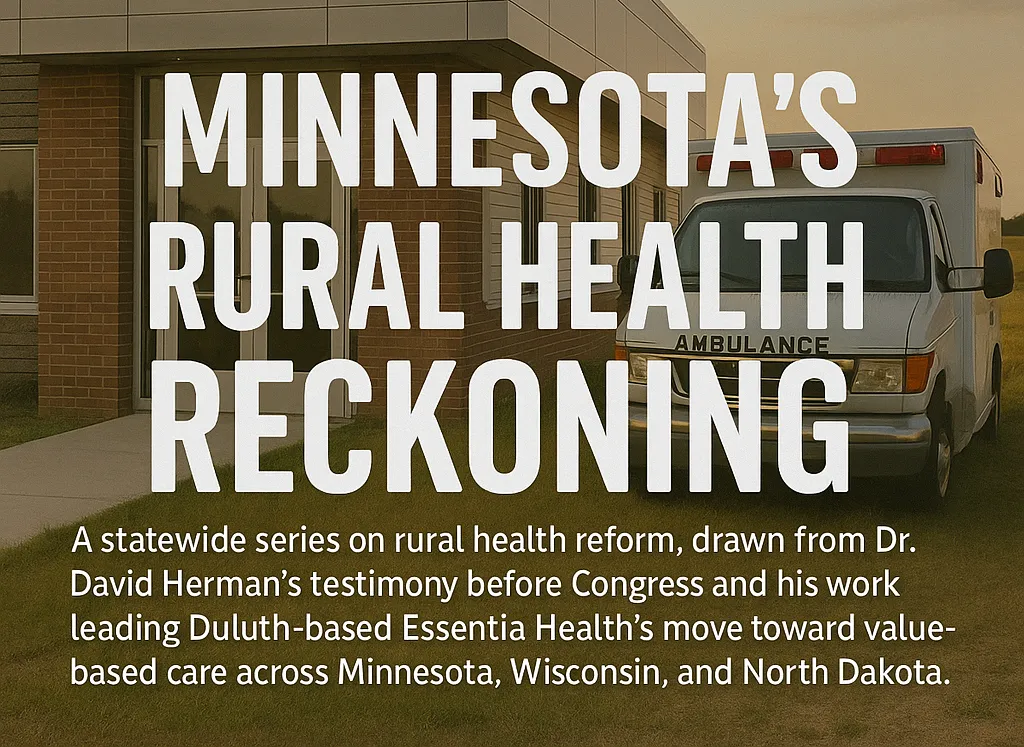This column is part of an ongoing statewide series examining the future of rural health care in Minnesota through the lens of Dr. David Herman, chief executive of Duluth-based Essentia Health. Drawing on Herman’s testimony before the U.S. Senate Finance Committee, the series explores how Minnesota’s hospitals are rewriting the national playbook for sustainable, patient-centered care. Each installment traces a different reform now shaping life across the 218 — from broadband access and drug-pricing battles to the human realities of workforce burnout and small-town survival.

Howie's column is powered by Lyric Kitchen · Bar
Doctors didn’t train to fill spreadsheets. Nurses didn’t join the profession to refresh drop-down menus. Somewhere between the oath and the audit, American medicine burned out its workforce.
It didn’t happen overnight. The steady accumulation of metrics, compliance checks, and electronic paperwork slowly replaced what used to matter most — face-to-face care. Every hour with a patient began to come with an hour behind a screen. The “art” of medicine gave way to data entry.
Dr. David Herman, the physician-CEO of Duluth-based Essentia Health, told Congress that value-based care might just be the antidote.
“Provider wellness has been at risk in our nation’s health care system, and the pandemic heightened these challenges,” he said. “Implementing value-based care programs enhances the care clinicians can provide … and provides opportunities to make the delivery of health care more rewarding and fulfilling.”
In plain language: if we fix how we measure care, we can fix how it feels to deliver it.
That philosophy is now reshaping hospitals and clinics from the Iron Range to rural North Dakota. Essentia Health, headquartered in downtown Duluth, has emerged as one of the country’s leading examples of what a community-based health system can accomplish when it refuses to surrender to bureaucracy.
Essentia’s pivot to team-based care means a physician no longer carries the chart alone. Pharmacists monitor medication use; care coordinators chase follow-ups; social workers handle transport and housing issues. That frees clinicians to do what they actually love — treat patients.
This redistribution of work sounds simple, but it’s revolutionary in practice. The physician becomes part of a circle, not the center of it. Each professional contributes where their expertise is strongest, turning the care plan into a shared mission instead of a solitary burden.
In small-town hospitals from Deer River to Brainerd, that model has quietly revived a sense of community inside the walls. It has brought meaning back into rooms where exhaustion once ruled. A nurse can leave her shift knowing she didn’t just “process visits” — she helped a mother find transportation to dialysis, or made sure an elderly neighbor’s prescription didn’t lapse. Those wins add up.
The cultural shift was deliberate. Herman created committees that give frontline providers control over redesigning workflows.
“Leadership support and engagement from physicians and providers are essential,” he said. “A new model is required to best care for our patients and communities.”
That commitment to listening may be Herman’s most underrated reform. For decades, health systems treated clinicians like replaceable cogs — measured in relative value units and throughput rates. Essentia flipped that hierarchy. It started asking those closest to the patient: What’s slowing you down? What tools would make your day easier?
The answers changed everything.
By improving referral tracking, care coordination, and telehealth access, Essentia reduced the clerical drag that had made modern medicine unbearable. Fewer mouse-clicks per patient. Fewer faxes. Fewer hours spent re-entering information the computer already knew.
In an industry that lost 100,000 nurses nationwide during the pandemic, that sentence is survival strategy. Burnout isn’t cured by yoga sessions or slogans; it’s cured by purpose. When a nurse sees her diabetic patient’s numbers improve because the system caught a food-insecurity flag early, she remembers why she stayed.
Essentia’s internal surveys show climbing morale as documentation hours drop. The result isn’t just happier staff; it’s safer care.
“The model of care developed to improve outcomes in value-based programs leads to best practices for all patients,” Herman testified. Translation: good systems heal caregivers too.
That phrase — heal caregivers too — might be the hidden thesis of rural health reform. In regions like northern Minnesota, where hospitals can’t just hire replacements from big-city labor pools, morale becomes mission-critical. Retaining even one veteran nurse can mean the difference between stability and crisis.
Herman’s approach has drawn attention from both policymakers and peers. When he testified in Washington, lawmakers heard something rare: optimism rooted in reality. His message wasn’t theoretical — it came from real clinics, real patients, and real doctors learning to breathe again.
Essentia’s value-based care model now touches more than 2 million lives across Minnesota, Wisconsin, and North Dakota. Its lessons ripple through rural America: empower teams, measure outcomes, align incentives with compassion. Every time the model prevents one unnecessary hospitalization or connects one struggling family with food support, the math — and the mission — improve.
Across the state, rural hospitals are watching closely. Administrators in Ely, Hibbing, Moose Lake, and International Falls often cite Essentia’s Duluth hub as a model of sustainability. When they ask how to retain physicians, the answer isn’t a bigger paycheck — it’s a better system.
Nationally, analysts note that Duluth’s homegrown health system has achieved what many academic centers still struggle with: integrating digital health records, preventive outreach, and local trust into a cohesive care network. Rural innovation, once dismissed as small-scale, is now informing national policy.
Herman’s testimony and Essentia’s data have been entered into federal discussions on modernizing Medicare payment and stabilizing rural hospitals. Lawmakers across party lines have cited the system as proof that efficiency and empathy aren’t opposites. In fact, they may depend on each other.
Inside the organization, the results are visible in everyday details — fewer missed referrals, smoother discharges, more gratitude in the hallways. The unglamorous fixes have produced something priceless: a workforce that once again feels part of something bigger than itself.
“Leadership support and engagement from physicians and providers are essential,” Herman said. “A new model is required to best care for our patients and communities.”
That sentence echoes beyond Essentia’s campuses. It’s a call to every hospital in the country still treating burnout as a side effect instead of a symptom.
If health reform ever feels abstract, remember this: every chart fixed by policy is a human being spared another 12-hour shift of futility.
And every system that heals its healers helps restore something bigger — faith that rural America can still lead the nation in caring for its own.
Minnesota’s Rural Health Reckoning is an independent 13-part series by columnist Howie Hanson. No organization sponsored this reporting.





